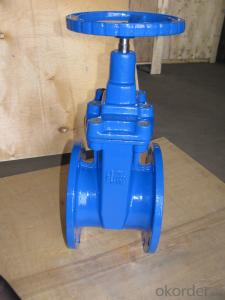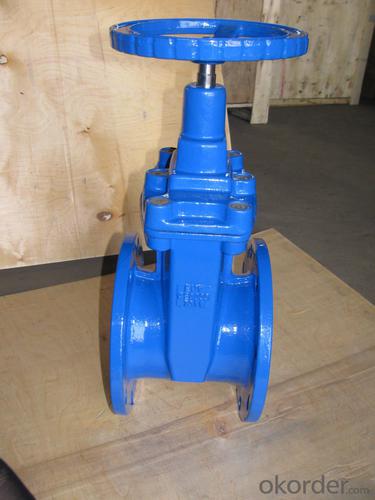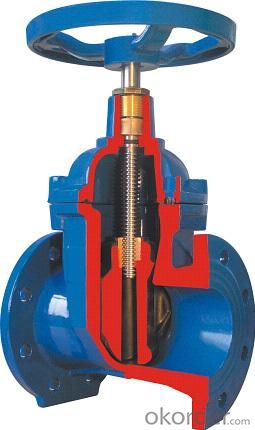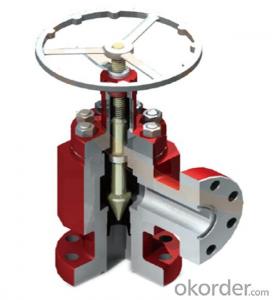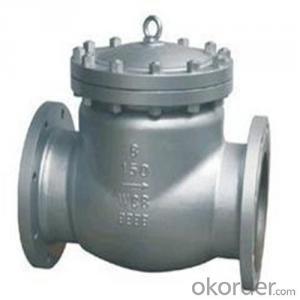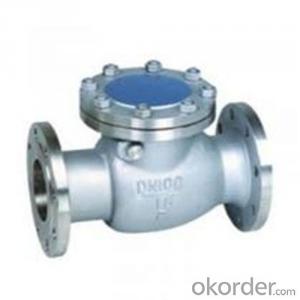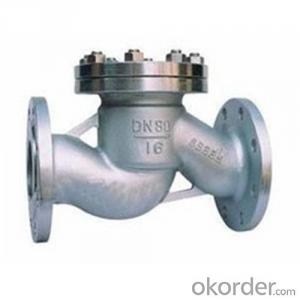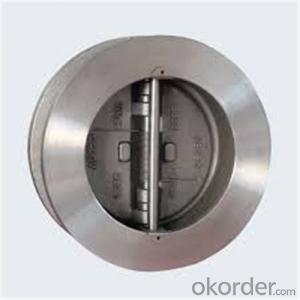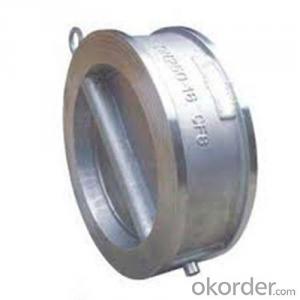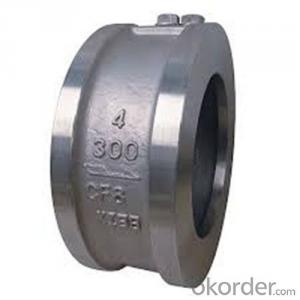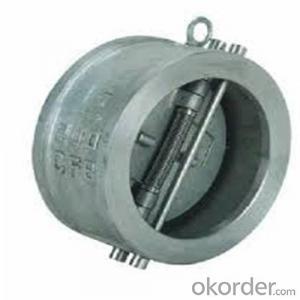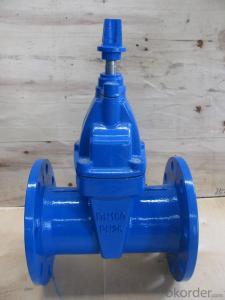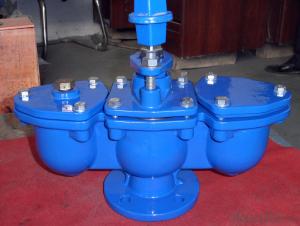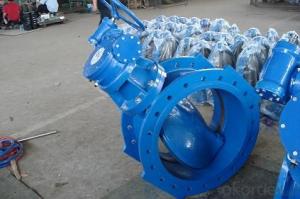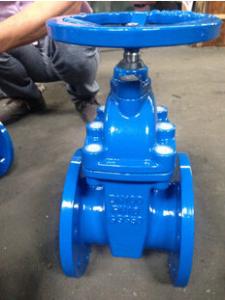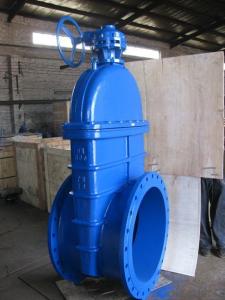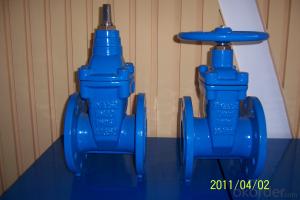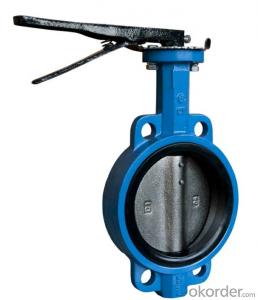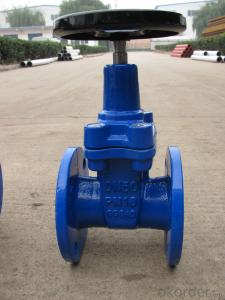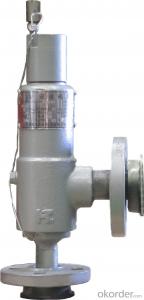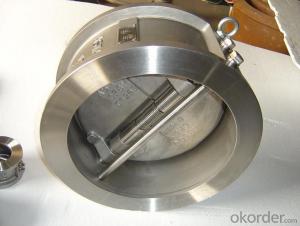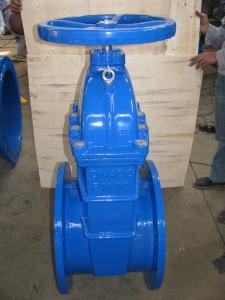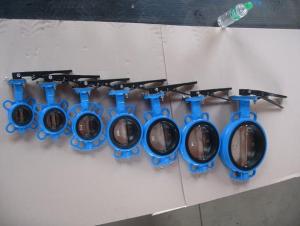Gate Valve of Ductile Iron Dismantling Joints With Double Flanges
- Loading Port:
- China main port
- Payment Terms:
- TT or LC
- Min Order Qty:
- 1000 set
- Supply Capability:
- 50000 set/month
OKorder Service Pledge
OKorder Financial Service
You Might Also Like
1.Structure of Gate Valve Description:
1. Selected materials, in line with domestic and international standards, high overall quality of the material.
2. In line with the requirements of domestic and foreign advanced standards, reliable sealing, excellent performance, attractive appearance.
3. Sealing pair advanced and reasonable, gate and seat sealing surface with different hardness Stellite (Stellite) cobalt-based alloy cladding made, reliable sealing, high hardness, wear resistance, high temperature, corrosion good anti-abrasion performance, long life.
4. Stem quenched and nitride surface treatment, has good corrosion resistance, scratch resistance and abrasion resistance.
5. The use of flexible wedge gate structure, medium and large caliber set thrust bearings, friction force is small, and with a striking manually open and close with ease.
2.Main Features of the Gate Valve:
1)Full port design
2)OS&Y Outside screw and yoke .
3)BB. Bolted Bonnet .
4)Flexible wedge, Fully guided
5)Choice of solid or split wedge .
6)Renewable seat rings
7)Forged T-head stem
3. Images of the Gate Valve:
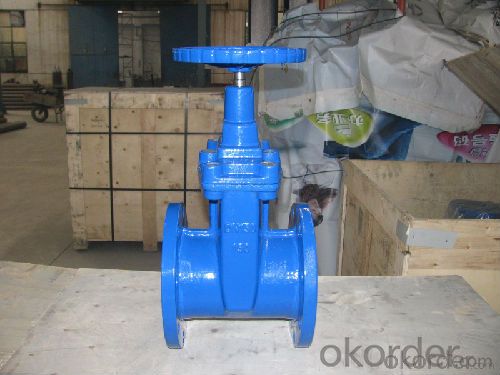
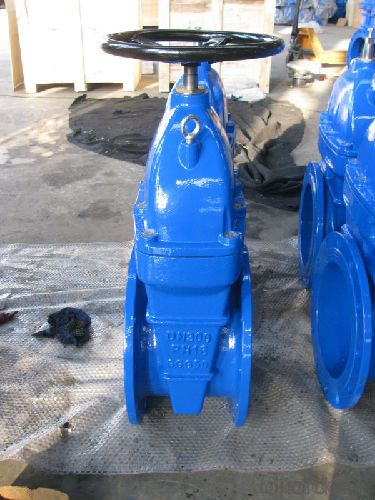
4. Specification of the Gate Valve:
1) Product information: the gate valves supplied are mainly used for adjusting water, steam, oil, gas, and natural gas in chemical industries
2) Standards: AWWA, DIN3352 F4/F5, BS5163, BS5150
3) Connection type: flanged type, push-on type, mechanical joint type, plain ends type
4) Size: 50-400mm/2" - 16"
5) Pressure grade: PN10, PN16
5.FAQ
1. Can I get free samples?
A: Yes,we can provide you the free sample, but you need to bear their own delivery costs.
2. Can I request to change the form of packaging and transportation?
A:Yes, We can change the form of the packaging and transportation according to your request, but you have to bear their own costs incurred during this period and the spreads.
3. Can I request to advance the shipment?
A: It should be depends on whether there is sufficient inventory in our warehouse.
- Q: HAS ANYONE HAD VALVE REPLACEMENT (WITH PIG VALVE) OPEN HEART SURGURY. WHAT WAS THE RESULTS? HOW DO YOU FEEL NOW?
- porcine valves (pig valve) and bovine valve (cow valve) are used to replace damaged human heart valves for over 20 years. its very safe and credible as an alternative for patients requiring valve replacements. but these valves are not as durable as mechanical valves and will eventually need to be replaced.
- Q: My question mainly pertains to Electric Motor-driven Motor Operated Valve Actuators.
- Motor Operated Valves
- Q: Hey,I have a 1/2 diameter pipe and I want to place a valve on it. I need a valve that can be electronically controlled so the water flow can be started and stopped on demand. I plan to achieve this by connecting the valve to a 'relay' that will be connected to an ardunio or PIC that will programmed to determine when the water is to flow or stop. That make sense? So my question does anyone know a suitable type of valve? I've no experience with valves and there are so many types so I don't know where to start!I would be grateful for any suggestions :)Thanks!
- Your application is very do-able. ASCO makes a valve that would work for your application. A few used ones can be found on Ebay. A few thoughts: 1) The normal fitting that you would need for the mechanical connection is 1/2 NPT (National Pipe Thread). That is a very common thread in the US. If you have a PVC pipe, you would have to get a fitting to convert 1/2NPT fitting to smooth PVC. If you have a steel pipe, then it has to be threaded for 1/2 NPT. If it is copper, you may have to get a smooth ASCO valve and solder it together. Use teflon tape or pipe dope to make sure that it doesn't leak. 2) Be very careful of your voltage and current. Your relay coil should be a voltage and current draw that will not be too much for the ardunio or PIC output. Also, the relay contact should be able to provide enough current and voltage to run the ASCO valve. BE CAREFUL. ASCO valves have a lot of inrush current, which means that it draws a lot more power to activate that it would be to hold it. Your relay should be sized for the worst case. For example, if the ASCO valve is rated for 120 volts ac (VAC) and is rated at 240VA inrush and 12VA holding, that means that it requires 2 amps to pull it in (240/120) and .1 amps to hold it (12/120). The contacts of your relay should then be rated for at least 120VAC and 2 amps.
- Q: I have a 3-circuit sprinkler system in my yard (built by me, last year). I discovered this week that I overtightened the connection between the valves and the downstream pipes, and 2 of the three valves are cracked, and leaking, at the connection. I replaced all 3 valves, and now I need to reconnect them to the supply. But this means I'm working backward - when I bult the system last year, I worked downstream - I built the manifold first, connected the valves, then the remainder of each branch. Now, I have to make the new manifold fit the valves, and naturally, they don't line up perfectly. Any tips/tricks on connecting valves in this situation? Is there such a thing as flexible pipe that can withstand continuous pressure? I'm using unions at both ends of each valve to help things go together/come apart more easily.
- valve manifolds are something that requires practice and experience. i used to struggle with them at work until i did a good bit of them. 3 zones is not that many valves so it shouldnt be too difficult. if they wont line up exactly right, i would recommend adding longer peices of pipe to the mainline side of the vavles and re routing the supply line futher back and you will have more room to flex the pipe and vavles into the Tees and 90s. do not use any form of flexible pipe on any mainline. you will regret it. lol the bigger the hole you dig will give you the most room and the more pipe, and room will give you more flexability to build the manifold. it is easier to connect the valves the way you did it first though, but you can do it either way. good luck and hope this helps
- Q: So i finaly got my check valve and my airstone. The airstone is actually a flat round airstone and is 5 inches in diameter to be in my 10gallon. Is it to big? though i have a tetra whisper air pump for 10-30g.And how do i place the check valve? Do i put it closer to the tank or closer to the pump? (just to make sure since i heard so many different ways people put it). Or does it even matter?And lastly, do i put the OUT side of the check valve facing towards the tank or the pump?Thanks! after this im ready to install it!
- The airstone is not too big, unless it causes the water to bubble right out of the tank. Then you will need a valve to divert the excess air to an unused air line. If the airline is already cut, just put the check valve wherever the airline ends. If it's not cut you can put it anywhere. The arrow on the check valve should point toward the aquarium. If it says IN and OUT, then the OUT is on the aquarium side. If you want to test it to be sure, blow in one end of the valve. You can't blow air into the side that connects to the aquarium. Be sure there is a drip loop in the air pump electrical cord. If water were to somehow get in the air pump or drip on it, water might follow down the outside of the electrical cord and go into the the wall outlet. To make sure that doesn't happen be sure the cord is looped down lower than the outlet and then loops back up before it's plugged in. Get a second airstone any time in the next few weeks. About once a month, trade airstones, putting the recently used one into a jar with white vinegar. A week or so of soaking will unclog the airstone so that it can be used again several times before needing to be discarded. If you do have excess air, I find that running a piece of airline tubing to a spot away from sight and putting a short piece of pipe cleaner in the far end will muffle the hissing sound of the excess air.
- Q: My 3rd valve keeps getting stuck when i play it, i have valve oil, but its just not working, help please
- There are several possibilities. You may have buildup on either the valve or the casing. Cleaning it thoroughly should normally remove it, but every once in a Blue Moon it pays to take it in and have it professionally cleaned. They can inspect it at the same time and tell you if you have a bend or a ding in the casing. Sometimes they are really hard to spot, especially if they are hidden in one of the crevices of the detail work. A really good repair person can stick a scope down there and tell you if you have some kind of blockage in just a few minutes. The only way to really clean inside the casing yourself is to get a good bottle brush that fits inside with just a little bit of resistance. You should really get someone to show you how to do it the first time because you don't want to go scraping up the insides. There is one other possibility that is kind of rare. Sometimes you get some gunk up under the valve button and it sticks when you push it down. You should normally be able to see this just by looking underneath however. Best of luck and I hope you find your sticking point and are able to set it free.
- Q: I bought my first car recently. but it has a high idle and smoking problem, i already replaced the spark plugs. I've been reading about the exhaust gas re-circulation valve. but i cant find it. where exactly is the EGR valve located in a 1999 KIA Pride?
- the EGR wont reason a hissing noise, if the EGR replaced into undesirable, there could be a soft stumble off the line, or tough idle. a hissin noise sounds like a vacuum leak someplace. open the hood while the vehicle is working and notice in case you may hear the place the hissing is coming from. it ought to be coming from a line someplace.
- Q: I have several stations in my automatic lawn sprinkler system. Each station has a valve that contains: 1. Manual Shutoff, 2. Flow Control Knob, 3. Solonid, 4. Anti-Siphon valve. Any way my question is this, Why does water continue to flow even when the manual shutoff is turned off and the flow control is also turned off?
- the guy above me got to it before i did. sounds like either a diaprham has just gone out, or the solenoid plunger is stuck, or there is a rock or something inside the valve, not closing it all the way. like trying to close a door with your foot in it. it will not close all the way. A word of advice would be to go ahead and replace the anti-siphon valves with regular inline valves. anti-siphon valves are pretty much junk any type. As far as diagnosing the problem now, 1. check your timer's programming and make sure that its not sending out power to this zone all of the time. ( this would make the timer bad). 2. carefully open the valve up ( with the water turned off of course), and inspect the diaprham. if it has any tears or ripps in it, get a new diaphram, if not, then flush the lines out with the valve open to see if any debris is in the line( rocks pipe pieces, etc.) and clean it out. 3. take out the solenoid and make sure the plunger in it is not sticking. ( if so replace the solenoid). 4. if all else fails just simply cut out and replace the entire valve and plumb in a new one properly. personally i would use either Hunter PGV valves, Rainbird DVF 100 valves, or Irritrol 205 series valves. all are inline models. antisiphon valves tend to fail. i work on sprinkler systems full time for 95 $ per hour of labor for our company. hope this can help you out John A
- Q: My third valve won't move at all. I haven't played my trumpet in a while and I tried to oil it to get it to unstick but it still won't move at all. People say to screw it off but I can only unscrew the little cap at the bottom of the valve where you push in, not the white button at the top. Help please! Thank you so much! =]
- i got here across that Dennis Wick valve oil is a procedures more advantageous ideal to any that I easily have used. you'll locate it on Amazon. If cleansing with dish cleansing soap and heat water would not artwork, alongside with the Dennis Wick oil, I recommend that you're taking it to a restoration shop. be careful at the same time as cleansing now to not get any cork or felt moist. only dip the truly valve section into the water.
- Q: I got a '99 bmw 740il that is leaking and burning oil. It shoots smoke out the exhaust when i first start it from burning oil. And the car misfires when idling, i did a tune up and the spark plugs were soaked in oil causing the tune up not to help anything for long cause it was missfiring the next day. Does this sound like the valve stem seals? I bought new valve cover gaskets and grommets and im gonna replace those this weekend, im hoping that will help. Comments please
- The symptom of bad valve stem seals is blue smoke after sitting overnight. But once that smoke is gone, a bad valve stem seal won't have any effect on engine running or idling. And it certainly won't cause a misfire. Worn valve guides can do all those things. You have far more serious problems than just valve stem seals. Get a wet/dry compression test and a cylinder leakdown test to isolate the problem to either valves or rings.
Send your message to us
Gate Valve of Ductile Iron Dismantling Joints With Double Flanges
- Loading Port:
- China main port
- Payment Terms:
- TT or LC
- Min Order Qty:
- 1000 set
- Supply Capability:
- 50000 set/month
OKorder Service Pledge
OKorder Financial Service
Similar products
Hot products
Hot Searches
Related keywords
